Unpacking and publishing the Phaistos Disk since 1993
HOME | PREVIOUS | NEXT | SITEMAP
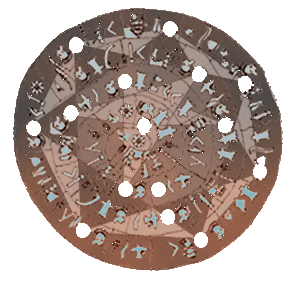
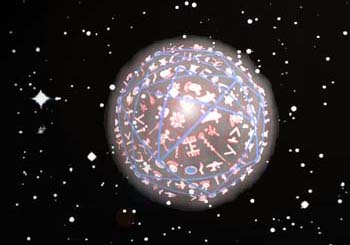 The light pours forth in spirals from the star and brings with it divine enlightenment.
The light pours forth in spirals from the star and brings with it divine enlightenment.
Spirals had already been painted on pots in prehistoric times as early as the Nagada II culture. Some researchers suppose that these alluded to coiled snakes, therefore the wavy lines on the same vessels would be creeping snakes. From the Middle Kingdom onward scarabs bore the royal name not in a cartouche but more often within a spiral or wreath of interlocking bands. In this case the symbolic significance is certain: the spiral line was the line of life, hence it is also found on amulets. The spiral symbolized the cycle of growth and decay, of birth and death and therefore had more than a merely decorative purpose in the tomb paintings of the Middle and New Kingdoms.
It was probably not by chance that the head-dress of the goddess Meskhenet consisted of a rod or stem ending in a double spiral, for she was a personification of the birth brick and was also thought to be present at the hour of the judgment of the deceased. It is quite likely that a magical effect and symbolic meaning were ascribed to the spiral, twisted lock of the divine child, the young Horus...The spiral symbolizes the unwinding of time. (g and g p. 116)
With the above information in mind, we perhaps are peering into the face of a Sothic Calendar, which was used by the Egyptians and apparently the Cretans, to keep all kinds of time -- sidereal time, inner time, months of the year, planting times, and harvest times. The Phaistos Disk attempts to map the internal realms and the architecture of the inner cosmos, as well. A big study, indeed, but one not too large for the priests and priestesses of Thoth.
Ephemeral axis material is needed now
The priests and priestesses of Thoth believed that spirals are the symbol of life, that ultimate reality is numerical, that number is the key to the universe, that triangles are the fundamental building blocks of the cosmos and that geometry is the Sacred Science. They were instructed as initiates in three divine areas of thought: Sacred Geometry, astronomy and philosophy. The numbers 60 and 5 were particularly sacred to their Religion of Time and the Mind.
The 30 line segments of each side of the Phaistos Disk total the sacred number 60. (One of the segments on Side 1 is the long thyrsuses, the tall symbolic wand made from cane or bamboo.) The number 60, in Hermetic literature of a much later period but said to have originated in ancient Egypt, represents the number of subordinate orders of the 3 divisions of the main cosmos, of which "there is an orderly harmonius movement of one to the other." (1) In the microcosm and corresponding to this macrocosmic arrangement are 4 main divisions of soul-stuff with 60 soul-spaces, called zones, firmaments or layers, comprising the 60 types of souls.
"And in these sixty spaces dwell the souls, each one according to its nature, for though they are of one and the same substance, they're not of the same dignity." (2)
The 60 soul types are layered in the Vast Vortex, the Crater or Cup. (Hermetic Krater or Graal, p. 132 go in lion path and get this info) Around the edges of the circular vortex, the souls, sinking down, "flutter round the vortex in a circle, not daring to go straight through it." (3) Spiritual ideas from antiquity, such as the Mighty Whirlpool, the Mixing Bowl of the Creator, and the mystical Spiral of Creation seem to be symbolized by the Phaistos Disk. The vortex, a rotating movement of cosmic matter round a center or axis, is supposed to account for the origin or phenomenon of the terrestrial and other systems. The 60 soul spaces and the vortex are visible on the Phaistos Disk, Sides 1 and 2, as spirals and separate compartments. The spirals may also represent of the spiral movement of the star Sirius through the constellations.
The idea of the Cup or Mixing Bowl as concentric circles or as a spiral "did not owe its origin to any invention of Plato's (427-347? BCE), but that the greatest of philosophers, when he makes use of the symbol, does but employ a familiar image well known to his audience...the symbol or image was a commonplace of the Orphic tradition, and doubtless, therefore, familiar to every Pythagorean." (4)
The vortex is also vertex, meaning "to turn or rotate." The vertex is the zenith, the point in the heavens directly overhead, represented by the flax flower on Side 1 and the star sign and the Nile sign on Side 2 of the disk. The Pythagoreans, who got their science from Egypt (via Crete? cgw), understood the vertex to mean the point opposite to and farthest from the base of a triangle, pyramid, or any figure having a base. Geometry thus originated with the study of the vertex-vortex and involved, pre-eminently, the triangle and its uses in describing the properties of a circle and the geometry of the sphere for use in astronomy.
 The properties of a circle are described efficiently by pi, 3.1416. The original Egyptian symbols for pi as seen on the Phaistos Disk might be the "Y" sign. The short line of the symbol is the radius (r) of a circle and the long line is the diameter (d). The ratio of the circumference of a circle (c) to its diameter (d=2r) is a constant number called pi, which equals c divided by 2r+3.1416. 2r with a vertex is a triangle = 3. The 14 pieces of Osiris = 3.14 = pi.
The properties of a circle are described efficiently by pi, 3.1416. The original Egyptian symbols for pi as seen on the Phaistos Disk might be the "Y" sign. The short line of the symbol is the radius (r) of a circle and the long line is the diameter (d). The ratio of the circumference of a circle (c) to its diameter (d=2r) is a constant number called pi, which equals c divided by 2r+3.1416. 2r with a vertex is a triangle = 3. The 14 pieces of Osiris = 3.14 = pi.
The triangle is the ancient Three Primordial Principles as expressed in geometry. The triangle is "sacred" because it represents the "plain of truth," the "hearth of the universe" and thesis-antithesis-synthesis. Gnosis is beyond reach unless one's feet have crossed the "plain of truth," meaning the study of Sacred Geometry and the triangle, particularly the magic 3-4-5 triangle.
The sacred 60 is also significant because long before 1600 BCE the 60-system of counting was used by the Mesopotamians, who were avid astronomers as were the Egyptians. The application of the sexagesimal (60-system) system in astronomy was continued by Greek and Hindu astronomers until about 500 CE. Since many of the constellation names originated in Crete and Greece, it is safe to say that, because of the symbols on the disk and the knowledge of the use of the 60-system by Greek astronomers much later, the 60-system was employed by the Cretans in their astronomical calculations. The three 60's--the 60 soul types of the vertex-vortex, the 60 of the 3-4-5 triangle (3x4=12x5=60), and the 60-system of counting in astronomy--are inseparable syncretisms, in terms of symbolisms found on the disk.
"And they (crocodiles of the Nile) lay sixty [eggs] and hatch them out in as many days, and the longest-lived of them live as many years-which is the first of the measures for those who treat systematically of celestial [phenomena]." (5)
"That is (re: the celestial phenomena), presumably, either the 60 of the Chaldaeans, or the 3x4x5 of the 'most perfect' triangle of the Mathematici." (6)
The most perfect triangle, the right triangle, "has its perpendicular [side] of 'three', its base of 'four,' and its hypotenuse of 'five...'" (7)
"And one might conjecture the Egyptians [also revered] the fairest of triangles, likening the nature of the universe especially to this..." (8)
The Egyptians, millennia before Pythagoras, employed the magic 3-4-5 triangle of the Pythagorean Theorem, c2=a2+b2. The result, 25, was the number of letters in the Egyptian alphabet. (9)
"And five makes a square equal to the number of letters among Egyptians, and a period of as many years as the Apis lives." (10)

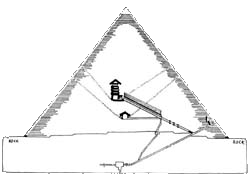
Pi inside the pyramid as a possible mathematical formula for its construction.
The Pi sign is repeated 3 times on Side 1. "Further, of trilateral figures, ...an obtuse-angled triangle is 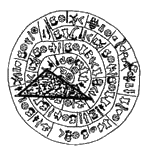 (3 Pi signs) that which has an obtuse angle... Two straight lines may produce adjacent angles
(3 Pi signs) that which has an obtuse angle... Two straight lines may produce adjacent angles 
 (4 sweeps connected) two angles in the same plane which have a common vertex and a common side but have no interior points in common.
(4 sweeps connected) two angles in the same plane which have a common vertex and a common side but have no interior points in common.
![]() "Osiris is Sun and is called Sirius by Greeks." (22) "For they write the King and Lord, Osiris, with 'eye' and 'sceptre.' (23)
"Osiris is Sun and is called Sirius by Greeks." (22) "For they write the King and Lord, Osiris, with 'eye' and 'sceptre.' (23) ![]()
Thus according to what seems to have been the general native tradition Osiris was a good and beloved king of Egypt, who suffered a violent death but rose from the dead and was henceforth worshipped as a deity. In harmony with this tradition he was regularly represented by sculptors and painters in human and regal form as a dead king, swathed in the wrappings of a mummy, but wearing on his head a kingly crown and grasping in one of his hands, which were left free from the bandages, a kingly sceptre.
The sceptre of Osiris appears 4 times on Side 2; 5 times on Side 1.
"Quadrilateral figures are contained by four straight lines. Quadrilaterals may be formed of two triangles." 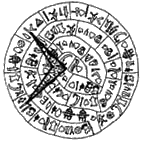 (4 Sceptres) This produces a geometry that becomes significant and references the Great Pyramid once again.
(4 Sceptres) This produces a geometry that becomes significant and references the Great Pyramid once again.
 While Osiris was away cleaning up the world, evil brother Typhon determined to do away with him, but Isis held the power in his absence and prevented it. Like Tiamat of Mesopotamia, Typhon has a serpent's body
While Osiris was away cleaning up the world, evil brother Typhon determined to do away with him, but Isis held the power in his absence and prevented it. Like Tiamat of Mesopotamia, Typhon has a serpent's body  and like Leviathan after him Typhon is the Great Serpent of evil. Also like Leviathan Typhon is indispensable to the order of the world, so long as he keeps to his place. When the opposites, thesis and antithesis, were synthesized in the Womb of Rhea, Typhon kept to his place, but when the harmony was disturbed Typhon rose up like Leviathan and like Teli the Dragon, who usurped Paradise and cast out Adam and Eve. Typhon usurped the throne of Good-doing Osiris and cast him out. Typhon, Tiamat and Teli may have been patterned on Draco, the constellation of the Dragon. The Typhon/Serpent sign appears 5 times on Side 1; 1 time on Side 2.
and like Leviathan after him Typhon is the Great Serpent of evil. Also like Leviathan Typhon is indispensable to the order of the world, so long as he keeps to his place. When the opposites, thesis and antithesis, were synthesized in the Womb of Rhea, Typhon kept to his place, but when the harmony was disturbed Typhon rose up like Leviathan and like Teli the Dragon, who usurped Paradise and cast out Adam and Eve. Typhon usurped the throne of Good-doing Osiris and cast him out. Typhon, Tiamat and Teli may have been patterned on Draco, the constellation of the Dragon. The Typhon/Serpent sign appears 5 times on Side 1; 1 time on Side 2.
 Horus is also represented by "the golden hawk, who flies nearest the sun, and gazes upon it with unwinking eye." (68) (From whence may have come the Cretan legend of Icarus, son of Daedalus, who put on wings and flew to the sun to gaze upon it. The sun melted his wings and he fell to earth. By these correspondences, if Icarus is Horus, then the mysterious Daedalus is Osiris.)
Horus is also represented by "the golden hawk, who flies nearest the sun, and gazes upon it with unwinking eye." (68) (From whence may have come the Cretan legend of Icarus, son of Daedalus, who put on wings and flew to the sun to gaze upon it. The sun melted his wings and he fell to earth. By these correspondences, if Icarus is Horus, then the mysterious Daedalus is Osiris.)
The hawk carries in its claw the "Bone of Horus," (69)  the naturally occurring magnet called the lodestone and "bone of the sea-hawk." (70)
the naturally occurring magnet called the lodestone and "bone of the sea-hawk." (70)
She had conceived him while she fluttered in the form of a hawk over the corpse of her dead husband. The infant was the younger Horus, who in his youth bore the name of Harpocrates, that is, the child Horus. (golden bough, chap 38)
After his death, Osiris, "coming to Horus out of the Invisible, worked through him and trained him for the fight" (82) (with Typhon), which "lasted for many days and Horus won." The golden hawk with the lodestone grasped in its claw appears 5 times on Side 1 in combination with the snake, an ancient symbol of electromagnetism.
Before the fight began:
"And it was said that as many were changing over to the side of Horus, Thueris, Typhon's concubine, came, too; and that a certain serpent pursuing after her was cut in pieces  by those round Horus. And today on this account they cast down a small rope and cut it in pieces for all to see." (83)
by those round Horus. And today on this account they cast down a small rope and cut it in pieces for all to see." (83)
On Side 2 of the disk the pieces of the serpent that pursued Thueris appear once beside the plumed head of Horus. On Side 1 they appear 5 times, each time beside the golden hawk of Horus. The hawk fighting the snake 
 symbolized the battle of Horus and Typhon. Horus was often portrayed as having a hawk's head and a snake's body--a sacred serpent-bird.
symbolized the battle of Horus and Typhon. Horus was often portrayed as having a hawk's head and a snake's body--a sacred serpent-bird.
"At Hermes-city, however, as image of Typhon, they show us a hippopotamus on which stands a hawk fighting a snake..." (84)
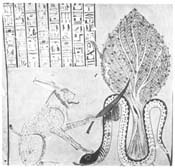
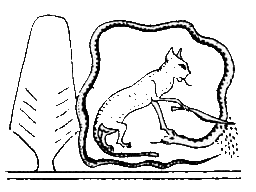
Another legend involving this serpent is that of Apophis, the serpent with the severed head. In this image from the tomb of Inkherka, "the great cat" is beheading the serpent in order to save the Persea tree it has wrapped itself around. 
The Cat, i.e., the Sun, which dwelleth by the persea tree in Heliopolis, cutting off the head of the serpent Apepi, emblematic of his enemies.(ebod, p.280)
"Each morning and evening the serpent demon threatened the son-god and thus endangered world stability. The 'huge serpent' was the embodiment of the opponent of God and a symbol of the powers of darkness. Therefore Apophis was equated with Seth (Typhon), the enemy of the gods. Each morning, when the son emerged from the nether-world, and each evening at the beginning of its nightly voyage, the sun barqoe was attacked by the serpent. This caused the sky to be dyed red with the blood of the defeated and wounded Apophis. The serpent also tried to hinder the sun's journey with its coils, described as 'sandbanks'. Several extant ritual texts refer to the 'overthrowing of Apophis' and provided magical protection, of which it was written 'it really saves him (i.e. the protected person) from all evil.'" (Lurker, p.29)
The serpent also symbolizes a star "because it does not age, and moves without limbs with ease and pliancy." (85) In this respect, the snake may symbolize the constellation Serpens Cauda.
On the Phaistos Disk appears a symbol that looks like a UFO. 
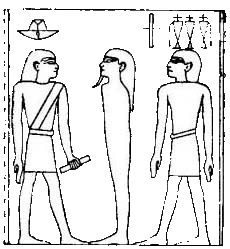 Left and below are similar symbols on images from the Egyptian Book of the Dead. The symbol is above the head of a priest.
Left and below are similar symbols on images from the Egyptian Book of the Dead. The symbol is above the head of a priest.

Perhaps this symbol really is a UFO, seen from the Great Pyramid, the secret house of Osiris. The secret house is a well-kept secret, indeed. It is only revealed by the Phaistos Disk when the Cheops signs  on Side 1 are connected. In Euclidean geometry, this is the method of showing a 4-sided pyramid in a 2-dimensional plane.
on Side 1 are connected. In Euclidean geometry, this is the method of showing a 4-sided pyramid in a 2-dimensional plane.
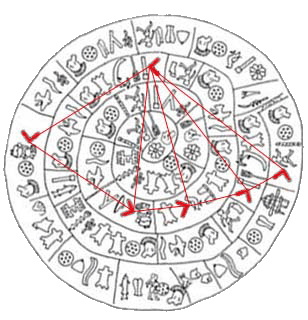
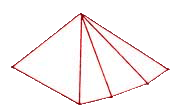
When Typhon trapped Osiris inside a coffin and tossed him into the Nile River, Isis set out on her skiff to look for him. She traveled to the kingdom of Byblos, where she was employed as a nurse by the queen. Her nursling was the child Diktys.
"And they say that instead of giving it the breast, Isis reared the little one by putting her finger into its mouth..." (56)
 This sign of Isis Unveiled, Isis pre-eminently meaning "Nurse" in Greek, a further intensification of "suckle," (57) shows Isis nursing Diktys by placing her finger in his mouth. In mourning for Osiris, she "beats her breast." Because Isis cut off a curl and put on her mourning dress, "whence the city to this day bears the name Kopto," (58) meaning "I cut or beat the breast," as a sign of her mourning. (59) The Isis-Diktys sign appears twice on each side of the disk, in each instance exactly equidistant apart.
This sign of Isis Unveiled, Isis pre-eminently meaning "Nurse" in Greek, a further intensification of "suckle," (57) shows Isis nursing Diktys by placing her finger in his mouth. In mourning for Osiris, she "beats her breast." Because Isis cut off a curl and put on her mourning dress, "whence the city to this day bears the name Kopto," (58) meaning "I cut or beat the breast," as a sign of her mourning. (59) The Isis-Diktys sign appears twice on each side of the disk, in each instance exactly equidistant apart.
"I am all that has been and is and shall be, and no mortal her ever re-vealed my robe." (60)
But Isis gave the babe her finger instead of her breast to suck.. (golden bough, chap 38)
"And they say that instead of giving it the breast, Isis reared the little one by putting her finger into its mouth..." (56)
Lactantius tells us how on these occasions the priests, with their shaven bodies, beat their breasts and lamented, imitating the sorrowful search of Isis for her lost son Osiris.. (GB, chap 39)
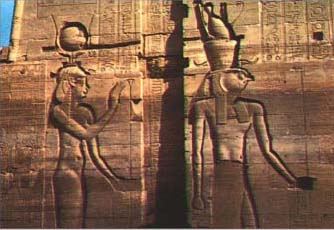
The original meaning of the goddess Isis is still more difficult to determine than that of her brother and husband Osiris. Her attributes and epithets were so numerous that in the hieroglyphics she is called “the many-named,” “the thousand-named,” and in Greek inscriptions “the myriad-named.” Yet in her complex nature it is perhaps still possible to detect the original nucleus round which by a slow process of accretion the other elements gathered. For if her brother and husband Osiris was in one of his aspects the corn-god, as we have seen reason to believe, she must surely have been the corn-goddess. There are at least some grounds for thinking so. For if we may trust Diodorus Siculus, whose authority appears to have been the Egyptian historian Manetho, the discovery of wheat and barley was attributed to Isis, and at her festivals stalks of these grains were carried in procession to commemorate the boon she had conferred on men. A further detail is added by Augustine. He says that Isis made the discovery of barley at the moment when she was sacrificing to the common ancestors of her husband and herself, all of whom had been kings, and that she showed the newly discovered ears of barley to Osiris and his councillor Thoth or Mercury, as Roman writers called him. That is why, adds Augustine, they identify Isis with Ceres. Further, at harvest-time, when the Egyptian reapers had cut the first stalks, they laid them down and beat their breasts, wailing and calling upon Isis. The custom has been already explained as a lamen for the corn-spirit slain under the sickle. Amongst the epithets by which Isis is designated in the inscriptions are “Creatress of green things,” “Green goddess, whose green colour is like unto the greenness of the earth,” “Lady of Bread,” “Lady of Beer,” “Lady of Abundance.” According to Brugsch she is “not only the creatress of the fresh verdure of vegetation which covers the earth, but is actually the green corn-field itself, which is personified as a goddess.” This is confirmed by her epithet Sochit or Sochet, meaning “a corn-field,” a sense which the word still retains in Coptic. The Greeks conceived of Isis as a corn-goddess, for they identified her with Demeter. In a Greek epigram she is described as “she who has given birth to the fruits of the earth,” and “the mother of the ears of corn”; and in a hymn composed in her honour she speaks of herself as “queen of the wheat-field,” and is described as “charged with the care of the fruitful furrow’s wheat-rich path.” Accordingly, Greek or Roman artists often represented her with ears of corn on her head or in her hand.
Such, we may suppose, was Isis in the olden time, a rustic Corn-Mother adored with uncouth rites by Egyptian swains. But the homely features of the clownish goddess could hardly be traced in the refined, the saintly form which, spiritualised by ages of religious evolution, she presented to her worshippers of after days as the true wife, the tender mother, the beneficent queen of nature, encircled with the nimbus of moral purity, of immemorial and mysterious sanctity. Thus chastened and transfigured she won many hearts far beyond the boundaries of her native land. In that welter of religions which accompanied the decline of national life in antiquity her worship was one of the most popular at Rome and throughout the empire. Some of the Roman emperors themselves were openly addicted to it. And however the religion of Isis may, like any other, have been often worn as a cloak by men and women of loose life, her rites appear on the whole to have been honourably distinguished by a dignity and composure, a solemnity and decorum, well fitted to soothe the troubled mind, to ease the burdened heart. They appealed therefore to gentle spirits, and above all to women, whom the bloody and licentious rites of other Oriental goddesses only shocked and repelled. We need not wonder, then, that in a period of decadence, when traditional faiths were shaken, when systems clashed, when men’s minds were disquieted, when the fabric of empire itself, once deemed eternal, began to show ominous rents and fissures, the serene figure of Isis with her spiritual calm, her gracious promise of immortality, should have appeared to many like a star in a stormy sky, and should have roused in their breasts a rapture of devotion not unlike that which was paid in the Middle Ages to the Virgin Mary. Indeed her stately ritual, with its shaven and tonsured priests, its matins and vespers, its tinkling music, its baptism and aspersions of holy water, its solemn processions, its jewelled images of the Mother of God, presented many points of similarity to the pomps and ceremonies of Catholicism. The resemblance need not be purely accidental. Ancient Egypt may have contributed its share to the gorgeous symbolism of the Catholic Church as well as to the pale abstractions of her theology. Certainly in art the figure of Isis suckling the infant Horus is so like that of the Madonna and child that it has sometimes received the adoration of ignorant Christians. And to Isis in her later character of patroness of mariners the Virgin Mary perhaps owes her beautiful epithet of Stella Maris, “Star of the Sea,” under which she is adored by tempest-tossed sailors. The attributes of a marine deity may have been bestowed on Isis by the sea-faring Greeks of Alexandria. They are quite foreign to her original character and to the habits of the Egyptians, who had no love of the sea. On this hypothesis Sirius, the bright star of Isis, which on July mornings rises from the glassy waves of the eastern Mediterranean, a harbinger of halcyon weather to mariners, was the true Stella Maris. (GB, chap41)
Another Christian writer describes how the Egyptians, with shorn heads, annually lamented over a buried idol of Osiris, smiting their breasts, slashing their shoulders, ripping open their old wounds, until, after several days of mourning, they professed to find the mangled remains of the god, at which they rejoiced. (GB, chap 39)
When Isis cut off a lock of hair in mourning for Osiris that, too, was a symbolic gesture; also the determinative for the world 'mourning' consisted of three locks of hair. It is questionable as to how far one should connect this with the shaven heads of priests, which symbolized subjection to divine. (god sand goddesses, p.57)
Sirius was called Sopdu by the Egyptians and Sothis by the Greeks. Astrologers imagined Sirius to be Isis. (g and g, p 72)
Isis is described as "great lady, divine mother," and Nephthys as "the mistress of the underworld." (ebod, p 260)
 His mother beats her breast and weeps for him, and those who are in chains with him (i.e., Isis and Nephthys) beat their breasts. (ebod, p 266)
His mother beats her breast and weeps for him, and those who are in chains with him (i.e., Isis and Nephthys) beat their breasts. (ebod, p 266)
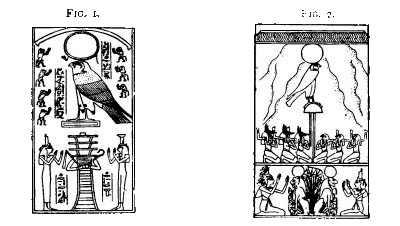
The hieroglyph for Horus, son of Isis, was the falcon on the perch, ![]() seen 3 times on the disk, once on Side 2; twice on Side 1.
seen 3 times on the disk, once on Side 2; twice on Side 1.
The morning sun was regarded as a falcon in its aspect of son and the evening sun was seen as a man in its aspect of father. (g and g, pl 90
In the beginning Horus was imagined to be a sky god whose image was seen as that of a falcon with outstretched wings, whose eyes were regarded as the sun and moon…Since not only the sky, but the sun also, were seen as a falcon, the king, sun and sky became identified and this found its final expression as the royal symbol of the winged disc. (g and go, p. 65)

![]() The festival [of Osiris] opened on the twelfth day of Khoiak with a ceremony of ploughing and sowing. Two black cows were yoked to the plough, which was made of tamarisk wood, while the share was of black copper. (GB, chap 39)
The festival [of Osiris] opened on the twelfth day of Khoiak with a ceremony of ploughing and sowing. Two black cows were yoked to the plough, which was made of tamarisk wood, while the share was of black copper. (GB, chap 39)
The infant was the younger Horus, who in his youth bore the name of Harpocrates, that is, the child Horus. Him Buto, the goddess of the north, hid from the wrath of his wicked uncle Set. (GB, chap 38)
But Isis put the coffer by and went to see her son Horus at the city of Buto... (GB, chap 38)
Boutos or Buto may also mean the constellation Bootes, the Ploughman, (94) symbolized by the yoke.
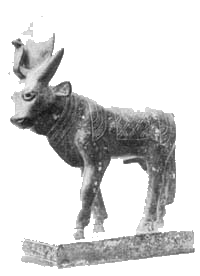 In Greece is celebrated the Mysteries of Dionysus (Osiris), (89) and the women invoke him by praying for "the god with the bull's foot
In Greece is celebrated the Mysteries of Dionysus (Osiris), (89) and the women invoke him by praying for "the god with the bull's foot  to come" to them. The bull's foot appears twice on Side 2, both times upside-down and both times in combination with an Osirian heaven-walker, symbolizing Osiris as the Apis-bull. It also may symbolize the constellation Taurus.
to come" to them. The bull's foot appears twice on Side 2, both times upside-down and both times in combination with an Osirian heaven-walker, symbolizing Osiris as the Apis-bull. It also may symbolize the constellation Taurus.
The bullsfoot may be upside down because, "A symbol is meant to direct the initiate to something higher and to reveal it to him at the same time, but it must also conceal this from the ignorant. Knowledge of the meaning of images was not accessible to everyone." (Lurker, p.9)
"...the Apis bull ws that of Ptah." (g and g, p.26)
In the Archaic Period (3100-2686 BCE) the bull was already thought of as having a special relationship to heaven. One Pyramid Text (No 470) mentions the 'Bull of Re who has four horns' which guarded the roads of heaven. The sun and moon bore the epithet 'bull of heaven'. The symbolic significance of this animal found expression in the bull cults which were spread throughout the land. The Lower Egyptian nomes had a bull as their emblem. The sacred Mnevis bull was regarded as a mediator of the god, Atum; the Apis was the 'glorious soul' of Ptah, and Buchis, who was venerated in Hermonthis. (Armant), was regarded as the 'living image of Month', but was also seen as the herald Re. (g and g, p 35-36)
The kings of the New Kingdom (1567-1085) often bore epithet 'mighty bull' or 'strong bull of Horus', (g and g, p. 35-36)
Bull's foreleg was the symbol of physical power. (g and g, p. 91)
 The ceremonies which took place at the door of the tomb in an Egyptian funeral are of considerable interest. The priest called Kher-heb, holding the Sem priest by the arm, gives directions for the slaughter of "a bull of the South." The slaughterer, standing on the bull, cuts off a fore-leg (Fig. 3) and takes out the heart. (ebod, p 265
The ceremonies which took place at the door of the tomb in an Egyptian funeral are of considerable interest. The priest called Kher-heb, holding the Sem priest by the arm, gives directions for the slaughter of "a bull of the South." The slaughterer, standing on the bull, cuts off a fore-leg (Fig. 3) and takes out the heart. (ebod, p 265

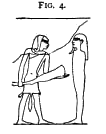

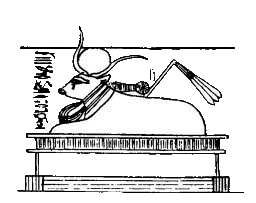
Two straight lines may intersect, producing vertical angles. 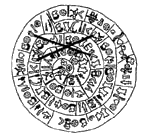 (2 Bull's feet, 2 Falcons on the perch connected) "If two straight lines cut one another, they make the vertical angles equal to one another." (16)
(2 Bull's feet, 2 Falcons on the perch connected) "If two straight lines cut one another, they make the vertical angles equal to one another." (16)
 After Anubis showed Isis where Typhon and his friends had thrown Osiris and his coffin into the Nile, she set out in her papyrus skiff (baris) (45)
After Anubis showed Isis where Typhon and his friends had thrown Osiris and his coffin into the Nile, she set out in her papyrus skiff (baris) (45) ![]() to look for him. When she found him and placed him in the marsh grass, Typhon again found Osiris and this time cut him up into 14 pieces and scattered him everywhere. Once again, Isis set sail to find Osiris.
to look for him. When she found him and placed him in the marsh grass, Typhon again found Osiris and this time cut him up into 14 pieces and scattered him everywhere. Once again, Isis set sail to find Osiris.
But Isis sailed up and down the marshes in a shallop made of papyrus, looking for the pieces; and that is why when people sail in shallops made of papyrus, the crocodiles do not hurt them, for they fear or respect the goddess. (gB p 38)
The papyrus skiff appears 5 times on Side 2, twice on Side 1. By connected the skiff signs, the constellation of 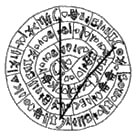
 Canis Major is seen.
Canis Major is seen.
LOOKING FOR THE NILE SIGN and the PIG Sign Osiris in the Nile is the archetype for purification by baptism in sacred water. To the ancient Egyptians who farmed the Nile Delta, Osiris literally was the Nile.
Copyright Notice - Disk of the World - Text and images copyrighted March 21, 1993-2025, Claire Grace Watson, B.A., M.S.T., U.S. Copyright and under the Digital Millennium Copyright Act of 1998, All rights reserved. No part of this web page may be reproduced or transmitted in any form or by any means without written permission from the author, except for the inclusion of brief quotations in a review.